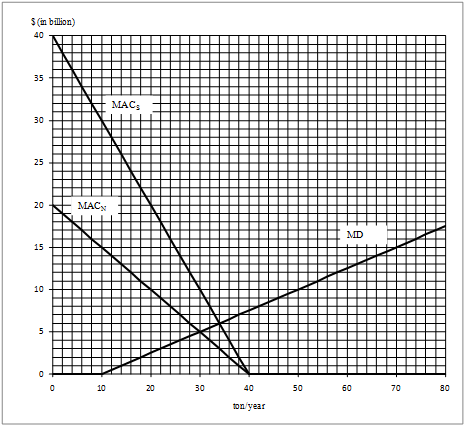Consider a model world which is subject to a risk of global climate change. The damage is known to be from greenhouse gas (GHG) emissions as indicated by the marginal damage curve (MD) in the figure below. The model world consists of two regions, the North and the South, which have difference in technologies for reducing GHG emissions and thus marginal abatement cost curves (MACN and MACS). Note that GHG emission in the North and in the South together threat global climate. Pushed by increasing awareness of environmental issues among public, the authorities in two regions agree to empower the UN to introduce and enforce whatever measures to reduce GHG emissions within technological constraints (i.e. MACN and MACs).

The UN is to reduce the GHG emissions to efficient level through command-and-control approach.
(a) What will be the standards in the North and the South?
North:
South:
(b) What will be the total abatement costs in the North and the South under these standards?
North:
South:
The UN is, instead, to reduce the GHG emissions to efficient level through a simple (one-part) emission charge.
(c) What will be the appropriate level of charge?
(d) How much will be the total emission charges (paid taxes) in the North and the South respectively in the equilibrium?
North:
South:
(e) The burden of emission charges is a concern of the authorities in the North and the South. How can the UN address to this problem while keeping incentive-based strategies? Give two ways to reduce/get rid of the burdens ("introducing transferrable discharge permits", which is studied below, will not be credited here).
The UN is, instead, to reduce the GHG emissions to efficient level through transferable discharge permits (each permit allows emission of 1 ton/year).
(f) How many permits should the UN issue? How much will a permit cost in equilibrium?
(g) Design the initial allocation of permits so that the South can benefit from reduced GHG emissions completely free of charge.
North:
South:
(h) What will happen to the price of permit when, while keeping the number of transferable permits issued by the UN, the North transfers its environmental technologies to the South so that the South is as cost-efficient as the North in reducing GHG emissions?
(i) How much will the North and the South emit GHG in equilibrium then?
North:
South:
(j) Is this an efficient equilibrium? If not, what should the UN do to achieve efficiency, while continuing to follow transferable discharge permits?